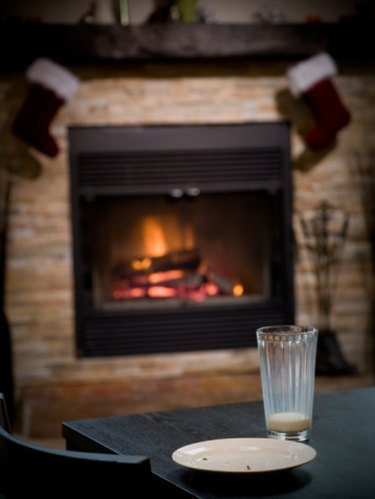Things You'll Need
Corrugated stainless steel tubing
Integral twin stage LPG regulator
Hammer drill
3/4-inch masonry bit
5/8-inch soft copper tubing
5/8-inch copper tubing compression fittings
Gas shut–off valve
Corrugated stainless steel tubing support brackets
Patio blocks
4-foot level
2 adjustable, open-end wrenches
Regulator pigtail
Copper pipe cutter
Tape measure

Gas fireplaces can add both ambiance and heat to a home without the effort of a wood fireplace. In locations where natural gas is unavailable, liquid propane gas, usually shortened to LP gas or just propane, can be used. Most often, a large tank is positioned outside the home and the gas piped to the fireplace. You must understand and follow all local codes related to tank placement and installation.
Step 1
Determine where you will install the propane tank, ensuring that the location meets requirements set by code for distance from buildings, vents and exterior appliances. Ensure that a delivery truck will be able to reach the tank and that the location is aesthetically pleasing.
Video of the Day
Step 2
Level the location for the tank with a shovel and position patio blocks to support the legs of the propane tank.
Step 3
Dig a trench 18 inches deep from the tank location to the foundation of the house.
Step 4
Drill a 3/4-inch hole through the foundation of the house into the basement or crawl space using a masonry bit.
Step 5
Install an integral twin stage LPG regulator on the propane tank using a regulator pigtail. The fittings on each end of the pigtail are identical. Thread one end into the outlet on the tank and the other into the inlet on the regulator. Tighten each connection firmly using an open end wrench. The pigtail is soft copper tubing and can be bent to fit the regulator under the weather hood on the tank.
Step 6
Connect a length of 5/8-inch soft copper tubing to the outlet port on the regulator using compression fittings and tighten using a pair of adjustable, open end wrenches.
Step 7
Lay the copper tubing in the bottom of the trench and cut it so it is long enough to extend through the hole in the foundation a minimum of four inches. Insert the tubing into the basement or crawl space. Fill in the trench with dirt.
Step 8
Measure the distance you will need to run corrugated stainless steel tubing from where the pipe comes through the foundation wall to the floor under the fire place. Purchase enough steel tubing to make the run.
Step 9
Connect the copper pipe inside the foundation wall to the corrugated stainless steel tubing using compression fittings. Tighten securely using the adjustable, open end wrenches.
Step 10
Drill a hole through the floor of the fireplace to the crawl space or basement. The hole needs to be large enough to allow the fitting on the flexible gas line and hose fitting which comes with the fireplace burner to pass through. Push the fireplace gas line through the floor into the basement or crawl space.
Step 11
Connect the corrugated stainless steel tubing and the gas line from the fireplace by attaching each line to the end of a gas shut-off valve using compression fittings and tightening all connections with adjustable, open-end wrenches.
Step 12
Use support brackets to hold the flexible, corrugated stainless steel tubing in position along the floor joists.
Tip
Turn on the gas then test each connection with a mix of equal parts water and dishwashing soap. If bubbles form, tighten the connection.
Video of the Day